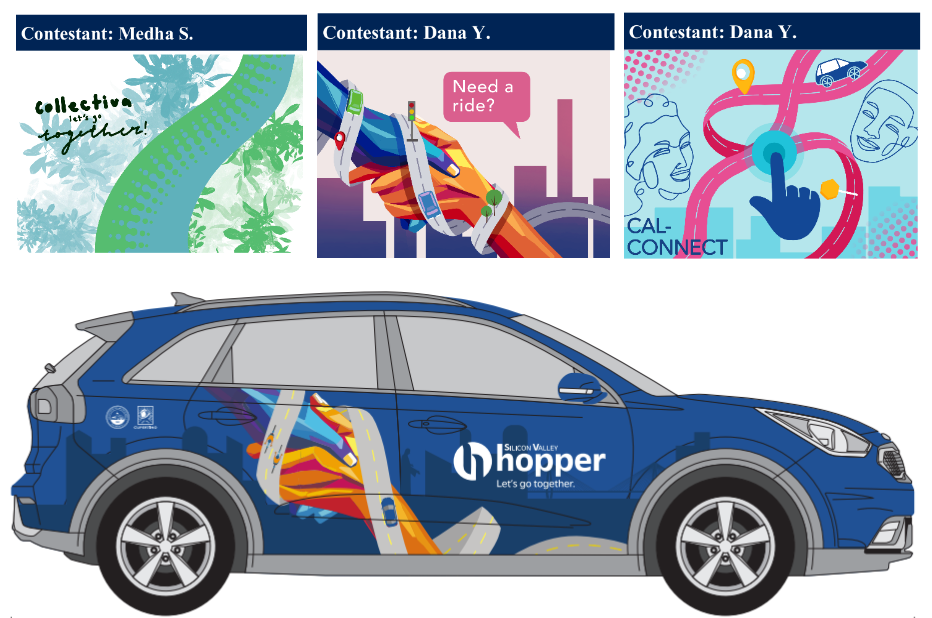Cupertino, California, home to some of the United States’ largest tech companies, congestion has been a problem for years. Commuters spend almost 20 minutes each day sitting in rush-hour traffic. The County’s fixed-route public transit network, designed for long-distance commuters, wasn’t cutting it for local trips — so in 2019, city leaders introduced Via Cupertino, an on-demand microtransit program, to fill gaps in coverage and improve first- and last-mile connectivity.
Cover image of Scene, Cupertino’s monthly magazine, March 2020 issue: "Via-Cupertino Community Shuttle Skyrockets to Success."
Four years later, 70 percent of riders report that they would have driven alone if the service was not available. “The more we all use this on-demand service, the more we help to lessen traffic congestion on our streets, reduce emissions in our air, and relieve parking in our most impacted areas, such as our library and well-used Civic Center,” says Deborah Feng, the former City Manager.
How did the City do it? By centering community needs in the service design, exploring creative options for long-term funding, and collaborating with neighboring cities to enhance mobility across Silicon Valley.

“I am proud of everything the Silicon Valley Hopper program has achieved in the last year by connecting residents to easy and cost-effective transportation. Its popularity has already paved the way for significant expansion, geographically and environmentally.”
Community-centered design fosters loyalty and adapts to evolving needs.
City planners need to identify their community’s unique goals to achieve, whether it’s filling first- and last-mile gaps to reduce congestion like Cupertino, or providing vital connections to services and resources for underserved communities like in many of Via’s other services. Connecting with that community, and keeping them involved with decision-making as the service launches and evolves, is vital to ensuring long-term success.
For Cupertino, community engagement began with a transit ridership survey, the results of which indicated a significant need for first- and last-mile mobility solutions and a desire for app-based, on-demand microtransit. Residents not only struggled to use existing transit to get around Cupertino without a car but also to get beyond the City for work and other opportunities. Service design prioritized both of these use cases with a core zone centered on Cupertino and points of interest outside the zone for El Camino Hospital and the Sunnyvale Caltrain station.
In just three months after Via Cupertino’s launch, a significant number of riders reported using it to connect to the existing transit network, especially Caltrain, the Bay Area’s popular commuter rail system. One rider reflected: “When I go to work in Cupertino from Mountain View, it's very important to me to have options that don't include driving. With Via Cupertino, I can bike or take the train to the Sunnyvale train station and catch a Via to work from there.”
Moreover, seniors, students, riders with disabilities, and other individuals who cannot drive or do not have access to a car reported enjoying the new freedom provided by this innovative transportation service. For example, Dmitry, a teacher with a visual impairment who works with students with visual impairments, said Via Cupertino is not only a critical part of his commute but also helps him travel around town to different teaching sites throughout the day.
When the City expanded the service to Santa Clara and rebranded as Silicon Valley Hopper in 2023, leaders maintained community excitement and buy-in by conducting a student design contest for the new vehicle wraps. The vehicles not only looked fabulous but truly reflected the spirit of the community they serve.

To celebrate the expansion and conversion to an all-electric vehicle fleet, Cupertino and Santa Clara staff harnessed the creative talents of local students and held an art contest for ideas on a new look. Via designers took elements of the finalist designs to create new vehicle wraps and a new service name, Silicon Valley (SV) Hopper. Source: Scene June 2023 issue.
📖 Read: Want to get riders excited about transit? Go electric.
A creative approach to funding is the key to financial sustainability.
With city-managed microtransit still relatively new as a public service, finding funding can be daunting. David Stillman, Cupertino’s Transportation Manager, called the search for eligible grants “a little challenging.” Though microtransit is eligible for more federal and state funding programs than many think, it pays to think creatively when approaching funding — especially for city governments, which are often eligible for fewer grant programs than transit agencies or rural communities.
In 2022, this creative approach won Cupertino an $8.5M grant to electrify and expand its microtransit service — from an unexpected source, California’s Transit and Intercity Rail Capital Program (TIRCP). A funding program that typically supports passenger rail infrastructure improvement projects to reduce greenhouse gas emissions. But Stillman knew the City’s microtransit service had a fighting chance: “We knew we’d have a very competitive application as we’re serving Caltrain stations,” he remembers. Additionally, by proposing to electrify its entire fleet, the City could demonstrate an immediate impact on emissions beyond improving sustainable transportation access to passenger rail transit.
Stillman notes that approaching funding alone would have been a challenge. Running a transit program — let alone funding one — was still a relatively new endeavor for Cupertino’s Transportation Division, which had previously focused on traffic operations and management.
“We appreciate Via’s assistance with the identification of grant opportunities and the completion of grant applications,” says Stillman. As the City looks forward to additional growth and expansion, he continues to work with Via’s team to identify new funding sources. “Right now, we're looking at potential TFCA funding and another grant from the EPA in cooperation with VTA and neighboring cities. These require a lot of analysis, such as emissions reductions we are expecting from the program. Via has been very helpful in assisting us in this regard.”
📖 Read: How 10 transit agencies and cities found funding to build and grow turnkey microtransit services

“Unless you have dedicated staff that has experience in this field, you want to look for somebody like Via that has that experience, full-time staff, and can provide that service for you and make sure it runs smoothly. That's key to the success we've had in Cupertino.”
Breaking regional transit silos unlocks long-term growth.
Similar to how Silicon Valley tech firms leverage the cluster effect, the City of Cupertino understands that the impact of transit is maximized when built collaboratively with interagency coordination. Sharing resources — funding, infrastructure, and expertise — leads to cost savings and a more sustainable use of available assets for all involved. Filling regional transit gaps beyond jurisdictional boundaries can also help expand access to employment and educational opportunities in neighboring counties and drive economic growth.
Stillman explains that Cupertino’s decision to partner with neighboring Santa Clara for their TIRCP application resulted in a more competitive application. Cupertino is now in discussions with the City of Sunnyvale to evaluate the feasibility of a potential partnership, with the hope of securing more funding down the road.
For cities that want to work together with other municipalities, Stillman shares this advice:
- Establish open, regular communication to identify shared goals. Hold regional planning meetings and workshops to find opportunities for better alignment with nearby cities.
- Share data and tools to develop a regional transit and mobility strategy. Planning tools like Remix are specifically designed to facilitate collaborative communication, both with other transit partners and with potential riders themselves.
- Have one primary contract for funding applications and procurement activities. “Instead of having multiple agencies all apply for the same grant and competing with each other over the same service, having just one agency as the responsible agency makes that process a lot more efficient and, in the end, a lot more successful,” Stillman says.
- Regarding the details of operation, cities should agree in advance on things such as fare structures, operating hours, and the level of service in each zone. As an example, Via has helped several partners align on mechanisms for calculating funding allocation for cross-city trips, etc.
What’s next?
In 2023 alone, 300+ services were launched in hundreds of cities and communities worldwide. Via Cupertino expanded service with more vans and greater coverage, transitioned to an EV fleet, and will continue operating for four more years thanks to the $8.5M state grant. Meanwhile, the City of Cupertino hopes to secure additional funding so it can continue to expand its reach in Santa Clara County.
“I am proud of everything the Silicon Valley Hopper program has achieved in the last year by connecting residents to easy and cost-effective transportation. Its popularity has already paved the way for significant expansion, geographically and environmentally,” says Sheila Mohan, Cupertino mayor, in the 2023 State of the City speech. We’re looking forward to seeing what year six will bring to SV Hopper!
Timeline: milestones for SV Hopper 5-year of the service.
October 2019
2020-2021
2022
2023
2023-2027

Data Journalist




%206.png?width=71&height=47&name=The%20Buzz%20Blog%20Hero%20(1750%20x%201200%20px)%206.png)